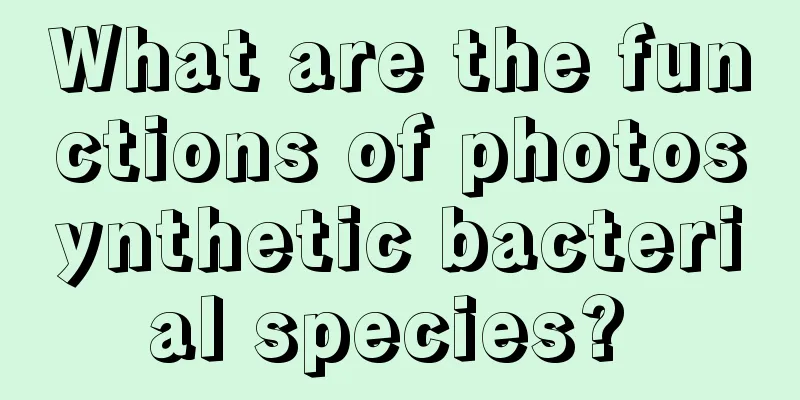What are the functions of photosynthetic bacterial species?

|
The growth of plants is inseparable from photosynthesis, and photosynthetic bacteria are a type of microorganism that can carry out photosynthesis, with the characteristics of high nutrition, high efficiency, and versatility. In today's aquaculture, planting and other industries, photosynthetic bacteria play an irreplaceable role and can help increase income in the aquaculture and planting industries. Next, I will introduce the functions of photosynthetic bacteria in detail! What are photosynthetic bacterial species? Photosynthetic bacteria are a type of microorganism that possesses photosynthetic pigments and can carry out photosynthesis. It is a highly nutritious, high-efficiency and multi-purpose biological product. Photosynthetic bacteria are rich in nutrients, containing protein, fat, soluble sugars, carotene, vitamin B and 16 kinds of amino acids. While absorbing light energy and carbon dioxide, photosynthetic bacteria can also use the organic acids, hydrogen sulfide and ammonia produced by the decomposition of residual organic matter in the water by foreign microorganisms, thereby achieving the purpose of purifying the water and providing food for organisms on the next level of the food chain, thus becoming an important link in the food chain in water. Light and bacteria have a strong ability to utilize light energy. Calculated by the volume of the organism, the ability of microorganisms to absorb carbon dioxide is 100 times that of forests. Because photosynthetic bacteria are rich in nutrients and have unique functions, they are widely used in various industries such as breeding, planting, medicine, and environmental protection. Effects of using photosynthetic bacteria in aquaculture 1. Purify water quality and extend water change time; 2. Maintain the microecological balance of the water environment; 3. Absorb oxygen consumption factors in water and increase oxygen in water; 4. Reduce the use of antibiotics and improve the quality of aquatic products; 5. Increase the zooplankton in the water as bait. The role of photosynthetic bacteria in planting 1. As a plant conditioner and fertilizer; 2. Separate the hydrogen in the soil and use the secretions from the roots of plants, organic matter in the soil, harmful gases (such as hydrogen sulfide), carbon dioxide, nitrogen, etc. as the matrix to synthesize sugars, amino acids, vitamins, nitrogen compounds and physiological substances to provide plant nutrition and promote plant growth; 3. The metabolites of photosynthetic bacteria can not only be directly absorbed by plants, but also become nutrients for the reproduction of other microorganisms, increasing the beneficial bacteria in the soil; 4. Help plants to carry out photosynthesis and absorb nitrogen, phosphorus, potassium and other elements from the atmosphere and soil, thereby reducing the use and residue of pesticides and fertilizers, improving the quality of agricultural and sideline products, and increasing economic benefits. |
<<: How long does it take to treat patellar chondromalacia? What are the treatments?
>>: Can fig leaves cure leukoplakia
Recommend
How many people die from stomach cancer?
Currently, there are more than 1 million new case...
How to prevent spring sleepiness
As soon as spring comes, you will feel very sleep...
Can a patient with lung cancer have a child?
Lung cancer is a malignant tumor of the respirato...
Is it normal for nasopharyngeal carcinoma patients to be deaf after radiotherapy and chemotherapy?
The course of radiotherapy for nasopharyngeal car...
Can peanuts and black beans be eaten together?
I believe that every household in modern society ...
How to get rid of the hot pot smell on your body?
When the weather is cold, you can invite some fri...
The hazards of egg boilers
Eggs are a nutritious product suitable for all ag...
Why do I keep farting when I have a fever?
It is inevitable that people get sick and have a ...
Symptoms of neurosis Six symptoms indicate
If the doctor tells you that you are mentally ill...
Symptoms of fetal restlessness
I believe that women will pay great attention to ...
How to prevent bone cancer in daily life
Many diseases that make patients sad and desperat...
What is the reason why the human body does not sweat
Due to physical reasons, some people love to swea...
What causes a bloated belly
Lower abdominal distension is also called lower a...
The efficacy and function of vinegar essence
When we buy vinegar, our family always tells us t...
The efficacy of Cynomorium songaricum and wolfberry wine soaking
We have all eaten wolfberries in our daily lives,...









